Cockatiel
Conservation status Least concern |
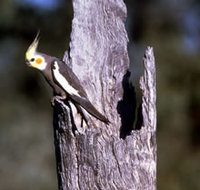
A wild cockatiel
|
|
Scientific classification |
| Kingdom: |
Animalia
|
| Phylum: |
Chordata
|
| Class: |
Aves
|
| Order: |
Psittaciformes
|
| Family: |
Cacatuidae
|
| Subfamily: |
Calyptorhynchinae
|
| Genus: |
Nymphicus
Wagler,
1832 |
| Species: |
N. hollandicus
|
|
|
Binomial name |
Nymphicus hollandicus
(Kerr, 1792) |
|
Synonyms |
Psittacus hollandicus Kerr, 1792
Leptolophus hollandicus |
The Cockatiel (Nymphicus hollandicus) is a
diminutive
cockatoo
endemic to
Australia and prized as a household
pet.
Description
The cockatiel is a small parrot of the
Cacatuidae family. Like some other cockatoos, as for example
the Sulphur-crested Cockatoo, the cockatiel has an erectible
crest. Cockatiels and cockatoos in general also share other
features, such as the facial feathers covering the sides of
the beak, which are rarely - if ever - found outside the
Cacatuidae family. In contrast to most cockatoos, the
cockatiel has long tail feathers, roughly making up half of
its total length. The cockatiel's distinctive pointed yellow
crest is held erect when startled or excited, while a
crest slightly tilted indicates a relaxed state of mind.
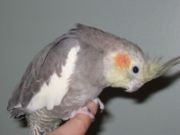
Female hand-raised cockatiel of typical
coloring, age 15.
The
plumage is generally mid-grey, lighter underneath, with
an almost perfectly round orange patch of feathers covering
the ear opening (usually referred to as a "cheek patch") and
a prominent white blaze on the
wings. A row of yellowish spots can be found underneath
the wings of female cockatiels, but not on the males. Some
other mutations exist, such as the Lutino, which lacks black
and grey color, being a light yellow colour overall. Female
Lutinos also have barred tail feathers. Both the cock and
the hen have yellow facial feathers: the female has a yellow
wash around the beak and eye, in the male, yellow covers
most of the head and the fore part of the crest. Male
cockatiels are very protective and nurturing of their
offspring and are known to be very capable of raising their
newborns if the mother is unable to.
Cockatiel lifespans in captivity are generally given as
15-20 years
[1], though it is sometimes given as short as 12-15
years
[2] and there are anecdotes of cockatiels living as long
as 30 years
[3].
Biology
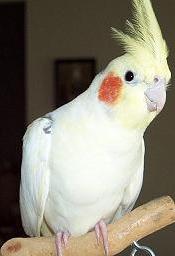
A captive-bred heavily pied cockatiel.
This is the only species in its genus Nymphicus.
Its relationships were long disputed; it was usually placed
into a
monotypic subfamily Nymphicinae or even allied with the
broad-tailed parrots. But while most other cockatoos are
500 mm to 600 mm in length, cockatiels are normally 300 mm
to 330 mm. There are several significant characteristics
that ally cockatiels with cockatoos though, including an
erectile crest, a gallbladder, and powder down patches.
Mitochondrial 12S rRNA sequence data (Brown & Toft, 1999)
has finally resolved the question of its affinities by
placing it in the "dark cockatoo" subfamily closest to the
genus Calyptorhynchus. The unusual, parakeet-like appearance
is a consequence of the decrease in size and accompanying
change of ecological niche. In spite of all its unique
adaptations, features such as the dark plumage, the barred
feathers of the female and the orange cheek patch are clear
morphological indications of its affinities.
The cockatiel's scientific name Nymphicus hollandicus
reflects the experience of one of the earliest groups of
Europeans to see cockatiels in their native habitat.
Travellers thought they were so beautiful that they named
them after the mythical creatures, the nymphs (Nymphicus
means literally "little nymph"). The species name refers to
New Holland, an old name for Australia.
Cockatiels are native only to Australia where they are
found largely in arid or semi-arid country, but always near
water. Sometimes hundreds will flock around a single such
body of water. They are absent from the most fertile
southwest and southeast corners of the country, the deepest
Western Australian deserts, and Cape York Peninsula. They are the only cockatoo
species that can breed in their first year.
Cockatiels as Pets
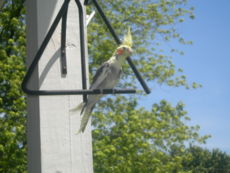
A pet Cockatiel.
Cockatiels are popular household pets in many parts of
the world. Today all pet cockatiels are bred in captivity,
as Australia no longer permits the export of native
wildlife, whether
endangered or not. Pet cockatiels have been bred to have
many different colorations (called mutations). Mutations
include lutino, pearl, cinnamon, pied, fallow, recessive and
dominant silver, whiteface, pastelface, yellowcheek, and
olive or 'spangled.'
Mutations can appear both individually or in a wide
variety of combinations such as lutino pearl, whiteface
pied, and whiteface lutino (which is often called albino,
but is not a true form of albinism). Still fairly hard to
find is the rather new 'olive' mutation. An olive cockatiel
does not actually have green pigment to its plumage, but
rather an overlapping pattern of yellow and grey that create
the illusion of a greenish cast.
Many mutations retain the black eyes, beak, nails and
grey feet of the normal grey cockatiels, however the lutino,
cinnamon and fallow mutations have pink to deep plum red
eyes, pink toenails and feet, and a horn colored beak. While
most mutations persist into adulthood for all cockatiels,
certain mutations like pearl are molted out in the males and
retained in the adult females. Sex-linked mutations such as
lutino and cinnamon have a higher ratio of female offspring
to male due to the mode of inheritance from parents to
offspring.
If hand-fed as chicks, cockatiels can form strong bonds
with their owners. Otherwise quiet birds will frequently
make contact calls with their owners, calls that sometimes
can be quite loud if the person is out of sight. Their
popularity as pets is in part because of their calm and
timid
temperament, to the point that they can even be bullied
by smaller but more confident birds such as
Budgerigars. Great care and supervision should be
provided when mixing cockatiels with other birds. It is not
uncommon at all for a larger or smaller bird to maim the
cockatiel, creating life-long disabilities and potentially
life threatening injuries. However, some cockatiels can
"scrap."
Although cockatiels are part of the parrot order, they
are better at imitating whistles than speech. Some do learn
to repeat phrases, and the males are generally better at
mimicry than the females. Cockatiels can mimic many sounds,
for example the bleep of a car alarm, a ringing telephone,
or the calls of other bird species such as
blue jays or
chickadees.
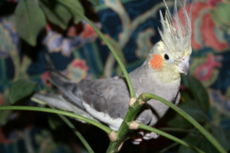
A Cockatiel with an erect crest
References
-
BirdLife International (2004).
Nymphicus hollandicus. 2006
IUCN Red List of Threatened Species. IUCN 2006. Retrieved on 06 May 2006. Database entry
includes justification for why this species is of least
concern
- Brown, D.M. & Toft, C.A. (1999):
Molecular systematics and biogeography of the cockatoos
(Psittaciformes: Cacatuidae).
Auk 116(1): 141-157.
External links




